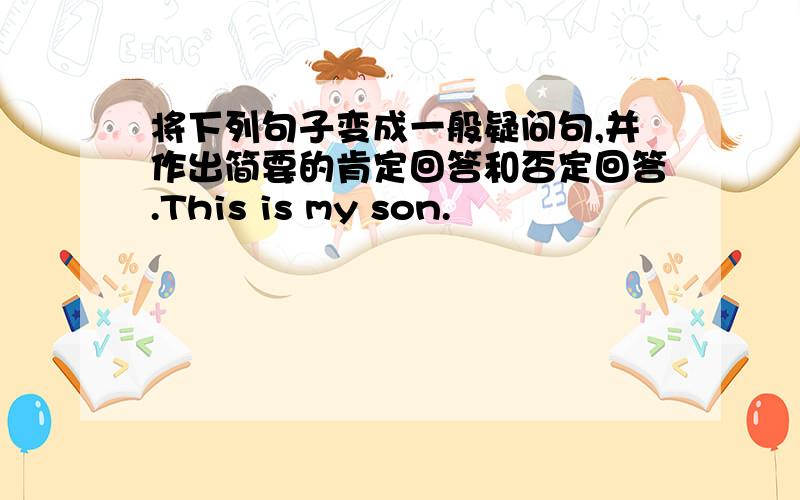将下列句子变成一般疑问句,并作出简要的肯定回答和否定回答.This is my son.
来源:学生作业帮 编辑:大师作文网作业帮 分类:英语作业 时间:2024/11/10 11:07:08
将下列句子变成一般疑问句,并作出简要的肯定回答和否定回答.This is my son.
1.This is my son.2.That is his sister 3.She is my good feiend 4.These are nice pictures.5.This is a middle school.
1.This is my son.2.That is his sister 3.She is my good feiend 4.These are nice pictures.5.This is a middle school.

我先回答你的答案,然后再补充语法知识.
1】is this your son?yes,he is /no,he is not
2】is that his sister?yes,she is/no,she isn't
3】is she your good friend?yes,she is/no,she isn't
4】are these nice pictures?yes,they are /no,they aren't
5】is this a middle school?yes it is /no ,it isn't
要特别注意人称的转换!
一般疑问句是疑问句的一种.它是指用yes(是)或no(否)来回答的句子.
其结构是:
系动词be/助动词/情态动词+主语+其他成分
通常回答为:
肯定:Yes,+主语+提问的助动词.
否定:No,+主语+提问的助动词+not.
如:
Are you from Japan﹖
Yes I am. / No I'm not.
Is her sister doing her homework now﹖
Yes she is. / No she isn't.
Does he work in a bank﹖
Yes he does. / No he doesn't.
Do you live near your school﹖
Yes I do. / No I don't.
Can you speak French﹖
Yes I can. / No I can't.
May I go home now﹖
Yes you may. / No you mustn't.
1.将陈述句变为一般疑问句时,如句中有be 动词(am/ is/ are)时,可直接将它们提至主语前.如主语为第一人称,应将其改为第二人称.如:
I'm in Class 2Grade 1. →
Are you in Class 2Grade 1﹖
We're watching TV. →
Are you watching TV﹖
2.陈述句中有情态动词(can、may、must …)时,也可直接将它们提至主语前,即可成为一般疑问句.如:
He can swim now. →
Can he swim now﹖
The children may come with us. → May the children come with us﹖
3.陈述句中只有一个实义动词作谓语且其时态为一般现在时,变为一般疑问句时要在句首加do或does 主语后的实义动词用原形.如:
I like these animals. →
Do you like these animals﹖
She wants to go to the movies. → Does she want to go to the movies﹖
1】is this your son?yes,he is /no,he is not
2】is that his sister?yes,she is/no,she isn't
3】is she your good friend?yes,she is/no,she isn't
4】are these nice pictures?yes,they are /no,they aren't
5】is this a middle school?yes it is /no ,it isn't
要特别注意人称的转换!
一般疑问句是疑问句的一种.它是指用yes(是)或no(否)来回答的句子.
其结构是:
系动词be/助动词/情态动词+主语+其他成分
通常回答为:
肯定:Yes,+主语+提问的助动词.
否定:No,+主语+提问的助动词+not.
如:
Are you from Japan﹖
Yes I am. / No I'm not.
Is her sister doing her homework now﹖
Yes she is. / No she isn't.
Does he work in a bank﹖
Yes he does. / No he doesn't.
Do you live near your school﹖
Yes I do. / No I don't.
Can you speak French﹖
Yes I can. / No I can't.
May I go home now﹖
Yes you may. / No you mustn't.
1.将陈述句变为一般疑问句时,如句中有be 动词(am/ is/ are)时,可直接将它们提至主语前.如主语为第一人称,应将其改为第二人称.如:
I'm in Class 2Grade 1. →
Are you in Class 2Grade 1﹖
We're watching TV. →
Are you watching TV﹖
2.陈述句中有情态动词(can、may、must …)时,也可直接将它们提至主语前,即可成为一般疑问句.如:
He can swim now. →
Can he swim now﹖
The children may come with us. → May the children come with us﹖
3.陈述句中只有一个实义动词作谓语且其时态为一般现在时,变为一般疑问句时要在句首加do或does 主语后的实义动词用原形.如:
I like these animals. →
Do you like these animals﹖
She wants to go to the movies. → Does she want to go to the movies﹖
将下列句子变成一般疑问句,并作出简要的肯定回答和否定回答.This is my son.
将下列句子变为一般疑问句并进行简要的肯定回答和否定回答...this..is..my..son
将下列句子变为一般疑问句,并进行简要的肯定回答和否定回答.1.this is my so
将下列句子变成一般疑问句,并作简要的肯定回答和否定回答:That is his sister
英语.将下列句子先变成否定句,然后变成一般疑问句,并做肯定和否定回答This is my uncle John.Thes
将下列句子改为一般疑问句,并作简要的肯定回答和否定回答
将下列句子变为一般疑问句,并作简要的肯定回答和否定回答 1. This is Gina.
将下列句子改成否定句和一般疑问句,并作出肯定或否定回答.
将下列句子变成否定句和一般疑问句并作肯定回答、否定回答
将下列句子变成否定句,一般疑问句并作肯定和否定回答.
将下列句子变成否定句,一般疑问句,并给出否定和肯定回答
将下列句子变成否定句,一般疑问句.并作肯定和否定回答.